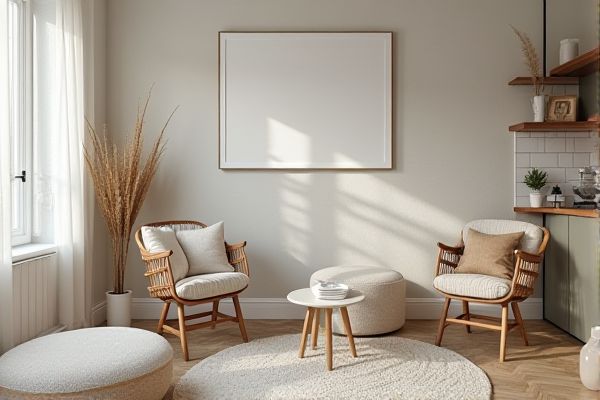
Painted walls offer a smooth, customizable surface that can be easily updated with new colors, while wallpaper provides intricate patterns and textures that add depth and character to any space. Discover the pros and cons of each option to decide which suits your style and needs best in the rest of this article.
Table of Comparison
| Feature | Painted Wall | Wallpaper |
|---|---|---|
| Installation | Simple and quick application using brushes or rollers. | Requires precise measuring and adhesive application; more time-consuming. |
| Cost | Generally lower material and labor cost. | Higher cost due to materials and installation complexity. |
| Design Variety | Limited to paint colors and finishes. | Wide range of patterns, textures, and designs available. |
| Durability | Resists wear but may require frequent repainting. | Durable and resistant to scratches; some types are washable. |
| Maintenance | Easy to clean with mild soap and water. | Requires careful cleaning to avoid damage; specialty wallpapers may be wiped. |
| Removal | Repainting covers old paint easily. | Can be difficult to remove; may damage walls. |
| Moisture Resistance | Depends on paint type; some paints are moisture-resistant. | Vinyl wallpapers offer good moisture resistance. |
| Environmental Impact | Low VOC paints preferred for eco-friendly options. | Varies; some wallpapers made from sustainable materials. |
Understanding Painted Walls vs Wallpaper
Painted walls offer a smooth, customizable finish that allows for easy color changes and repairs, making them ideal for dynamic interior designs. Wallpaper provides intricate patterns and textures that can add depth and personality to a room, often lasting longer without needing touch-ups. Understanding the durability, cost, and maintenance differences between painted walls and wallpaper helps homeowners choose the best option for their aesthetic and practical needs.
Key Differences in Aesthetic Appeal
Painted walls offer a smooth, customizable finish with a wide range of colors and textures that can be easily updated to match changing styles. Wallpaper provides intricate patterns and unique designs that create visual interest and depth, often serving as a statement feature in any room. Your choice between painted walls and wallpaper depends on the desired aesthetic, maintenance preferences, and the atmosphere you want to create.
Durability and Longevity Comparison
Painted walls typically offer greater durability and longevity compared to wallpaper, especially when using high-quality, washable paints that resist chipping and fading. Wallpaper can be prone to peeling, tearing, and damage from moisture, reducing its lifespan, particularly in high-humidity areas. Professional installation and maintenance can extend the life of both, but painted surfaces generally require less frequent replacement and upkeep.
Installation Process: Paint vs Wallpaper
The installation process of painted walls involves surface preparation, priming, and applying multiple paint coats with brushes or rollers, typically requiring less time and fewer materials than wallpaper. Wallpaper installation demands careful surface smoothing, precise measurements, adhesive application, and alignment to avoid bubbles and seams, often making it more labor-intensive and time-consuming. Paint allows for quicker touch-ups and changes, whereas wallpaper offers detailed patterns but requires professional skill for flawless application.
Maintenance and Cleaning Requirements
Painted walls generally require less maintenance and can be cleaned easily with mild soap and water, making them ideal for high-traffic areas prone to dirt and stains. Wallpaper demands more careful upkeep to avoid damage during cleaning, often necessitating specialized cleaners or gentle dusting to preserve patterns and texture. Choosing between painted walls and wallpaper hinges on balancing ease of cleaning against aesthetic preferences and long-term durability.
Cost Analysis: Initial and Long-Term Expenses
Painted walls typically offer lower initial costs with basic materials like primer and paint, ideal for budget-conscious renovations, while wallpaper involves higher upfront expenses due to material quality and installation labor. Over time, painted surfaces generally require periodic repainting every 5-10 years, which can incur moderate maintenance costs, whereas high-quality wallpaper may last 10-15 years but can involve costly repairs or complete replacement if damaged. Your choice between painted walls and wallpaper should weigh these initial and long-term expenses against durability, style preferences, and maintenance willingness for optimal cost efficiency.
Design Flexibility and Customization Options
Painted walls offer unparalleled design flexibility, allowing homeowners to easily change colors, create unique textures, or incorporate artistic techniques like stenciling and murals. Wallpaper provides intricate patterns and textures that are difficult to replicate with paint, including options like grasscloth, vinyl, and peel-and-stick varieties for quick customization. Both mediums enable tailored aesthetics, but paint excels in adaptability while wallpaper delivers complex, detailed visual effects.
Environmental Impact and Sustainability
Painted walls typically have a lower environmental impact compared to wallpaper, as paint formulas now include low-VOC (volatile organic compounds) options that reduce harmful emissions and improve indoor air quality. Wallpaper production often involves plastic-based materials and non-biodegradable adhesives, making it less sustainable due to challenges in recycling and disposal. Choosing eco-friendly paints or biodegradable wallpaper materials can significantly enhance sustainability in interior wall treatments.
Repair and Replacement Considerations
Painted walls offer easier and more cost-effective repair options, as small chips or cracks can be quickly fixed with touch-up paint. In contrast, wallpaper repairs often require matching patterns and can be more time-consuming, with damaged sections needing careful removal and replacement. Your choice between painted walls and wallpaper will impact the long-term maintenance, especially when considering the ease of repair and the potential costs of replacement.
Best Applications and Room Recommendations
Painted walls provide a versatile and cost-effective solution ideal for high-traffic areas such as living rooms, kitchens, and hallways, offering easy touch-ups and customization with countless color options. Wallpaper excels in bedrooms, dining rooms, or accent walls, where intricate patterns and textures can create focal points and add depth, especially in spaces where durability and moisture resistance are less critical. For optimal application, consider painted finishes in moisture-prone areas like bathrooms, while wallpaper works best in low-moisture environments to maintain longevity and visual appeal.
 homyna.com
homyna.com